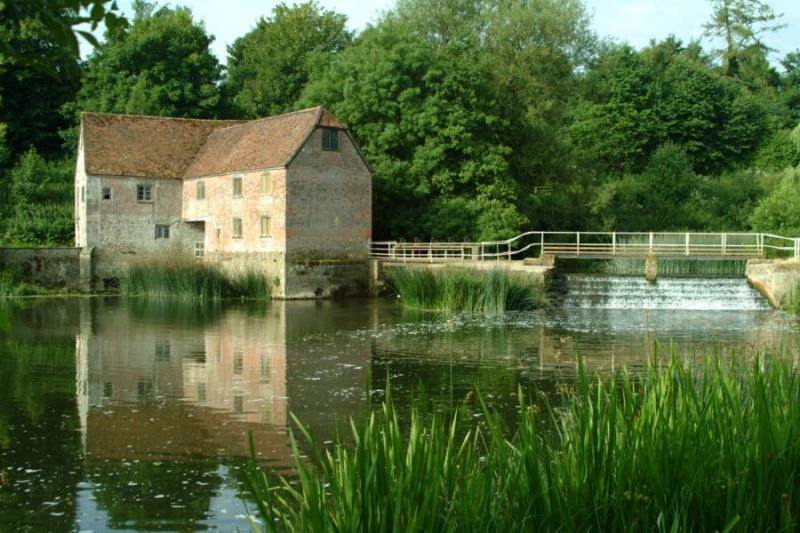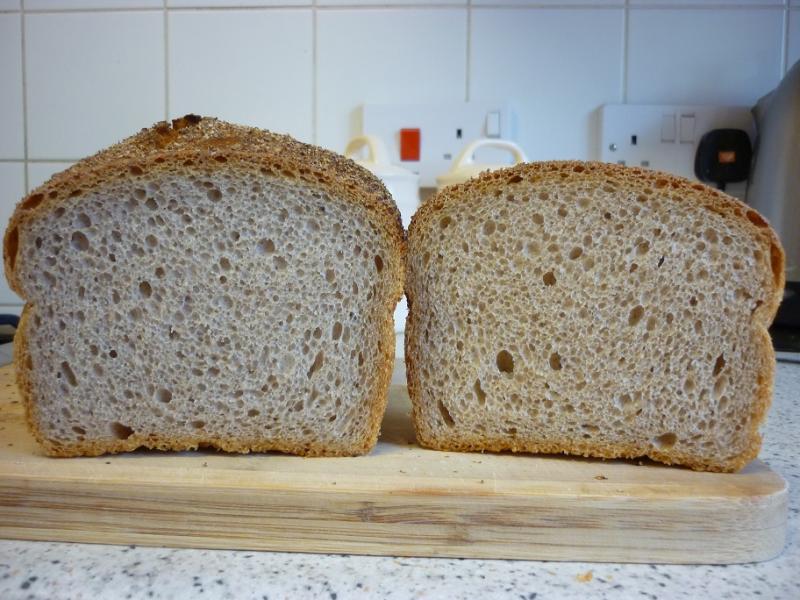On a flying visit to Dorset my family and I stopped off in Sturminster Newton to take a tour around the water mill. Wonderful! A very informative and interesting tour provided by delightfully friendly staff reminded us of times gone by. Fully automated machinery that is surprisingly old for the ingenuity. I highly recommend this tour.

This work is licensed under a Creative Commons Attribution-Noncommercial-No Derivative Works 3.0 License
At the end we were given some flour milled from locally grown wheat. Thank you Tony.
A few days later I set about making a loaf with this newly acquired flour
I can’t provide a comprehensive recipe as technically this wasn't without issue and I had to make a few on the fly adjustments to my devised recipe.
To begin I sifted the flour using my drum sieve to remove the majority of the bran because I don’t really like dense breads.
I fermented 80% of the flour as a Biga pre-ferment. However after around 16 hours the dough had deteriorated a little, but still, more than I would like. This flour really can’t handle much fermentation.
On putting the final dough together, after even a gentle mix the dough became overly slack and so I added a little extra white flour and some stock firm sourdough to compensate.
The final dough was a little on the weak side but it still managed to almost triple in size before baking. Oven spring was fairly good too.
Fully fermented Biga, Remaining sifted flour, total removed bran and my sieve.
The finished loaf with some of the sieved bran sprinkled on top.

Crumb

- mwilson's Blog
- Log in or register to post comments
Beautiful opening photo mwilson!
I'm torn between the lovely shot of the mill and the crumb of the loaf you made with the mill's flour, equally beautiful in different ways. My own recent experience using fresh/young flour from a heritage mill here in Canada is quite similar, particularly how quickly fermentation took place in the preferment and the handling characteristics you describe. Just going by the photo it looks like a loaf that would have excellent flavour, but what were your impressions?
Thanks for sharing these photos and your experience with the Sturminster Newton Mill flour.
Franko
Thanks Franko.
I'm not sure how old the flour was but I'm sure your Canadian flour, even fresh, is stronger than any wheat grown here but it's good to know I'm not alone on the poor fermentation front.
The loaf has a nice wheaty aroma but a very clean taste.
A please to share to share with you.
Regards,
Michael
I love the photo of the mill you visited! Seems like this is the summer of mill tours - in Canada and now in England (I am assuming that is where this one is located.) It is nice to know these buildings have been preserved for our generation to see and that they are still producing flour! Especially in this age of planned obsolescence.
Your loaf has a lovely color and the crumb looks very nice and light despite your description of the flour not handling the long fermenting. I always bake with freshly ground grains and keep the pre-fermented flour at about 12%-13% this time of year or else I end up with weakened dough too. By using a smaller amount of pre-fermented flour in my leaven I am still able to get a 12-14 hour bulk fermentation time in the refrig. and my doughs do maintain their strength. A trick I learned here. I can't help but wonder if that method would work with your fresh flour too....
Thanks for the photos!
Take Care,
Janet
Hi Janet,
The Mill dates back to the 11th century but was re-built in 1650. Really quite impressive that it's still here today but just as a working museum though.
The colour is really appealing, it signals nutrition. Nice and light just as I was aiming for. I don't do dense!
I agree it was silly or perhaps over ambitious to ferment 80% of the flour. I knew how wholemeal breaks down much quicker but I was hoping the drier environment of my starter would negate the protease activity. I'll try an even drier pre-ferment next time. I don't think using a sourdough culture would be possible as what little gluten there is, would be munched in no time!
Regards,
Michael
Hi Michael,
I know you have been around here for awhile now and I am guessing you have read comments about Peter Reinhart's book Whole Grain Breads but, just on the chance you haven't seen his book, it is great for baking with whole grains.
His method is 2 pre-doughs one of which is a stiff biga and the other a soaker. The biga uses 44% of the flour and is generally hydrated at 75%. The soaker uses 44% of the flour too and the rest of the water in the recipe is used in it so it is generally 75% hydrated too or a bit more. The biga gets a bit of the yeast in it and the soaker gets a bit of the salt in it. The rest of the salt and yeast are added into the final dough which is mixed 12 hours or so after the 2 pre-doughs have been mixed. The remainder of the flour (12%) is added to the final dough along with the salt and yeast and any enrichments you want to add.
(The biga is mixed and refrigerated immediately. The soaker is mixed and left at room temp.)
His whole premise is that with the 2 pre-ferments you get a much stronger dough when added together later on. He calls it his 'epoxy' method. It really improves the texture and strength of a dough when working with whole grains. I have always baked with whole grains but my loaves really changed when I learned about his method - revolutionized my whole idea of whole grain baking and while the technique looks time consuming, it really isn't at all.
Anyway - there you have my brief summary of his method which may or may not help you out at all in your next bake since I know the grains you are working with are different than the grains we have here...
Take Care :-)
Janet
Hi Janet,
I'm familiar with Reinhart's work and I have one of his books which has a section on wholegrain breads. There certainly could be improvements to be made in how I handled this flour but I get the impression it's a ability to handle fermentation is very poor... It's inevitable trend towards soup is very fast!
Thanks for taking the time to post those tips, I'll let you know if I make any improvements with the flour I have left...
Thanks,
Michael
I fine Reinhart's book very interesting and appealing. Surely using the same flours he used (mostly wholemeal hard wheat flour) would give excellent breads, but I'm equally sure that you need STRONG flours to get those results, or you wil get collapsed pastes that don't come together anymore.
The wholemeal flour sold in italy is exclusively milled from soft wheat, totally unfit for bread making (and I'm sure from the worst wheats!). Even sifting the flour very fine and using the white part gives a dough that doesn't even bear 10 minutes of low speed mixing. I guess that not only the quantity, but even the quality of proteins present in soft wheat flour doesn't permit any kind of decent rise.
Looks like you had some pretty good results by the appearance of your nice open crumb and perfect looking crust.
Does it taste as good as it looks?
Nice job.
Ian
Cheers Ian.
It tastes pretty good. Wholesome and yet light. A wheaty aroma with a smooth finish on the palate.
Michael
Hi Michael, what lovely pictures! That mill seems to have come out of a fairy tale!
Great bread, it looks light as you described it. Maybe the 16 hours of fermentation were too many? Every time I use wholemeal or partly wholemeal flour I end up with pastes that look exactly like my beloved rye bricks. Even getting a bread like yours would be an achievement!
Nico
Hi Nico,
Thanks. I'm glad my loaf didn't turn out like a brick! 16hr was indeed too long @ 50% hydration. I'll try something really low next time, like 38% maybe... I'll keep experimenting...
Michael
you got a beautiful crumb. And what a great picture of the (very) old mill. -Varda
Thanks Varda.
Visiting old mills sounds like a fine hobby. Glad to see your adjustments to the recipe worked out well. The crust and crumb turned out very well. What a good looking loaf of bread.
Nice post and bake.
Thanks dabrownman.
I'm not sure it's a hobby yet but this particular mill tour was very interesting...
Michael
Thanks for your nice travelogue/report Michael. Another destination to add to our neverending UK garden/sight tour list.
Can I ask where you got your flour sieve and what its specs are? I'd like to dabble in "highly extracting" my own flour from wholemeal, and have got a tip from Pat Roth (proth5) on sieves, but haven't bought one yet. I prefer the wooden look of yours (and Queensland Pips, for that matter) over the more steely types, for flour at least. Will be in UK next month and could order and have it delivered to family there beforehand. Thanks!
Cheers,
Tom
A pleasure to report Tom. I really hope you get a chance to take the tour when you visit.
The drum sieve aka tamis has a very fine mesh but was bought as a gift and so I don't know its specs or where it was purchased, sorry.
Glad you liked.
Cheers,
Michael